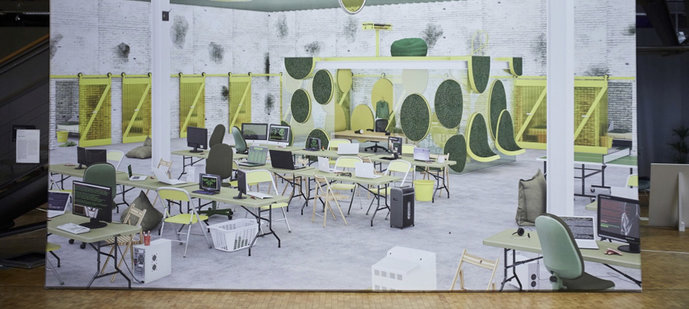

Exhibition view Open Codes, 2018, Photo: Sebastian Heck


Artwork at exhibition Open Codes, 2018 (detail), Shawn Maximo: Open Doors (2017), Photo: Sebastian Heck
“Another key feature of the computer code is its deceptive invisibility. Code remains hidden for most; it is itself immaterial and a normally invisible part of a machine, and yet has visible, concrete and tangible effects on the world.” (Peter Weibel)
“Another key feature of marketing is its deceptive invisibility. Code remains hidden for most; it is itself immaterial and a normally invisible part of a machine, and yet has visible, concrete and tangible effects on the world.”(Norina Quinte)
In her institution-critical work, Norina Quinte deals with the constantly expanding power of the mass media and marketing in the so-called digital age and their influence on the public. mit der stetig wachsenden Macht der Massenmedien und des Marketings im sogenannten digitalen Zeitalter und deren Einfluss auf die Öffentlichkeit. Quinte offers two phenomena of the “media turn” in the foreground.
- The merging of politics and economy and the resulting omnipresence of marketing.
- Change in the public and the increasing (institutional) focus on the consumer
The following questions emerge from the phenomena described above, starting from an interest in art theory: Has the art field been restructured as a result of increasing user interaction? Do artistic production and their institutions look more and more toward their “consumers”? Are artworks produced to answer to the “digital expectation”? And further, what messages doe the “Musem 2.0” send?
As a case example, the exhibition Open Codes – Leben in digitalen Welten is examined. The exhibition opened in 2017 at ZKM (Zentrum für Kunst und Medien) in Karlsruhe and offered not only in terms of content to the topic of digitalization and the world of codes, but its structure and build were characterized by digital aesthetics and communication strategies. What does the exhibition communicate? Or more precisely, does it primarily deal with communication strategies in the sense of a critical approach and awareness-raising for contemporary themes? Or is it in the end, about the market-oriented messages that slowly diffuse in the museum space, even in the supposedly free platform of art.
The subtitles to the work Museum Marketing and Communication Strategies in the Digital Age are hints to the main question of the research: Are marketing and advertising allowed entry into the museum space as a result of the digital turn, thus becoming museums themselves?
Tutors: Prof. Dr. Siegfried Zielinski, Dr. Lioudmila Voropai